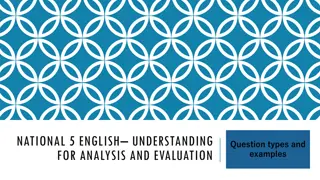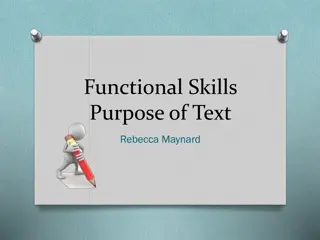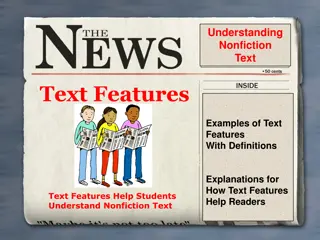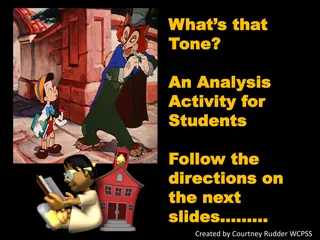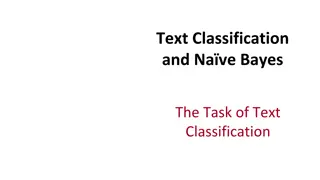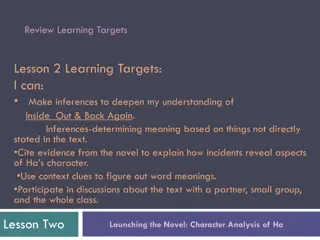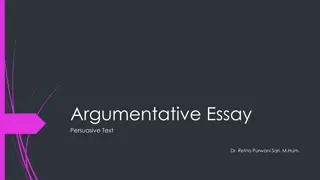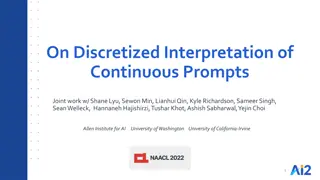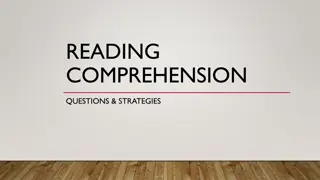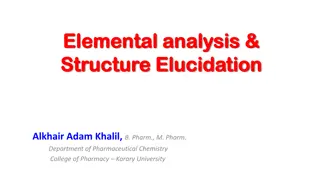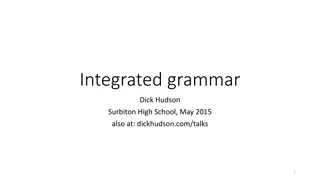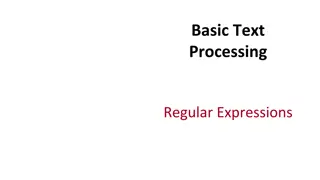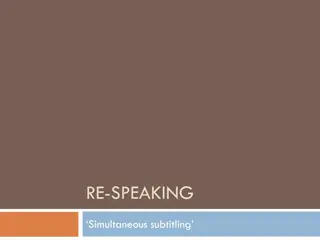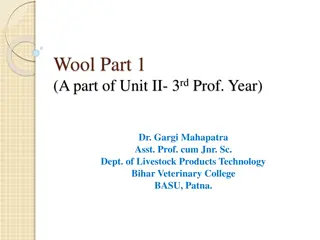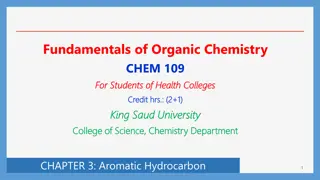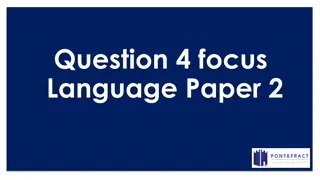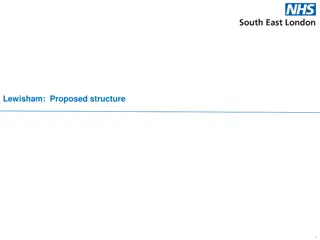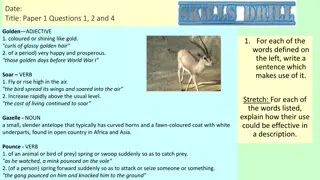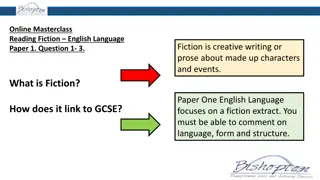Understanding Text Structure for Analysis
This content provides guidance on analyzing text structure in a literary extract. It explores how writers manipulate elements like setting, time, characters, tone, atmosphere, and dialogue to engage readers. The structured approach helps readers understand and evaluate the impact of these choices on the narrative and overall storytelling effectiveness.
Download Presentation

Please find below an Image/Link to download the presentation.
The content on the website is provided AS IS for your information and personal use only. It may not be sold, licensed, or shared on other websites without obtaining consent from the author. Download presentation by click this link. If you encounter any issues during the download, it is possible that the publisher has removed the file from their server.
E N D
Presentation Transcript
YOUR TASK: CONSIDERING QUESTION 3 Analysis You need to think about the whole of the source. A detailed examination of the elements in a text. An explanation as to WHY writers do what they do. Analysis includes discussion of the effects writers want to achieve and how they achieve it. The text is from the beginning of a short story. How has the writer structured the text to interest you as a reader? You could write about: - what the writer focuses your attention on at the beginning - how and why the writer changes this focus as the extract develops - any other structural features that interest you. (8 marks)
LOOK FOR THESE STRUCTURAL DEVICES IN THE EXTRACT STRUCTURE: The way a text has been put together INTRODUCTION OF/CHANGE IN SETTING is a structural device CHANGE IN TIME is a structural device INTRODUCTION OF NEW CHARACTERS is a structural device CHANGE IN TONE/ ATMOSPHERE is a structural device. DIALOGUE is a structural device
WHAT THE EXAMINER WILL SEE SIMPLE AWARENESS OF STRUCTURE (L1) Simple comment on the effect of structure (L1) Simple textual detail (L1) Simple use of subject terminology (L1) Candidate s answer will appear here on the examiner s marking screen. SOME UNDERSTANDING OF STRUCTURE (L2) Attempt to comment on the effect of structure (L2) Some appropriate textual detail (L2) Some use of subject terminology (L2) CLEAR UNDERSTANDING OF STRUCTURE (L3) Clear explanation of the effects of structure (L3) Range of relevant textual detail (L3) Clear/accurate use of subject terminology (L3) DETAILED AND PERCEPTIVE UNDERSTANDING OF STRUCTURE (L4) Analysis of the effects of structure (L4) Judicious textual detail (L4) Sophisticated use of subject terminology (L4)
WHAT THE EXAMINER WILL SEE The examiner will see the candidate s answer to the right of these comments. SIMPLE AWARENESS OF STRUCTURE (L1) Simple comment on the effect of structure (L1) Simple textual detail (L1) Simple use of subject terminology (L1) The examiner will then click and drag these comments onto your answer to show where you have met the criteria. SOME UNDERSTANDING OF STRUCTURE (L2) Attempt to comment on the effect of structure (L2) Some appropriate textual detail (L2) Some use of subject terminology (L2) CLEAR UNDERSTANDING OF STRUCTURE (L3) Clear explanation of the effects of structure (L3) Range of relevant textual detail (L3) Clear/accurate use of subject terminology (L3) This means that part of your answer could contain a L1 comment but also a L4 comment. This means that if part of your answer is L4 but the rest is L1, you will receive a mark in the L4 section of the mark scheme. DETAILED AND PERCEPTIVE UNDERSTANDING OF STRUCTURE (L4) Analysis of the effects of structure (L4) Judicious textual detail (L4) Sophisticated use of subject terminology (L4)
YOUR TASK: BE THE EXAMINER. MARK THE FOLLOWING ANSWERS Annotate the following answers with the comments on the left. See if you can identify the highest level the answer achieves and where it achieves it. SIMPLE AWARENESS OF STRUCTURE (L1) Simple comment on the effect of structure (L1) Simple textual detail (L1) Simple use of subject terminology (L1) SOME UNDERSTANDING OF STRUCTURE (L2) Attempt to comment on the effect of structure (L2) Some appropriate textual detail (L2) Some use of subject terminology (L2) CLEAR UNDERSTANDING OF STRUCTURE (L3) Clear explanation of the effects of structure (L3) Range of relevant textual detail (L3) Clear/accurate use of subject terminology (L3) DETAILED AND PERCEPTIVE UNDERSTANDING OF STRUCTURE (L4) Analysis of the effects of structure (L4) Judicious textual detail (L4) Sophisticated use of subject terminology (L4)
YOUR TASK: BE THE EXAMINER (CANDIDATE ONE) The extract begins with a description of the time of year. We are then SIMPLE AWARENESS OF STRUCTURE (L1) Simple comment on the effect of structure (L1) Simple textual detail (L1) Simple use of subject terminology (L1) introduced to a new character called Nat. Nat has a wartimedisability and doesn t work all the time. We learn lots of information about him. He likes SOME UNDERSTANDING OF STRUCTURE (L2) Attempt to comment on the effect of structure (L2) Some appropriate textual detail (L2) Some use of subject terminology (L2) to look at the birds. We know this because it says he would watch the birds . Perhaps the writer does this because we know the story is going to be about birds so it is introducing them to the reader. There are lots of them which CLEAR UNDERSTANDING OF STRUCTURE (L3) Clear explanation of the effects of structure (L3) Range of relevant textual detail (L3) Clear/accurate use of subject terminology (L3) means the story could be scary. The writer focuses on Nat who finishes for the day and he thinks the birds are restless because there is going to be a hardwinter . The writer talks about the weather again. The last line could DETAILED AND PERCEPTIVE UNDERSTANDING OF STRUCTURE (L4) Analysis of the effects of structure (L4) Judicious textual detail (L4) Sophisticated use of subject terminology (L4) be on a line by itself because it is important. It talks about a bird and we know birds are going to be important because of the title of the story.
YOUR TASK: BE THE EXAMINER (CANDIDATE TWO) The writer begins by establishing a sense of time and place. We are told it is SIMPLE AWARENESS OF STRUCTURE (L1) Simple comment on the effect of structure (L1) Simple textual detail (L1) Simple use of subject terminology (L1) December so the writer is already creating a dark, bleak tone. We are introduced to a new character, Nat Hocken, and du Maurier zooms in on his SOME UNDERSTANDING OF STRUCTURE (L2) Attempt to comment on the effect of structure (L2) Some appropriate textual detail (L2) Some use of subject terminology (L2) solitary and lonely nature. This could interest the reader because it portrays him as mysterious and somewhat secretive. He clearly likes the birds; they are part of his daily routine which would imply he prefers to spend his time CLEAR UNDERSTANDING OF STRUCTURE (L3) Clear explanation of the effects of structure (L3) Range of relevant textual detail (L3) Clear/accurate use of subject terminology (L3) with them rather than other people. The writer shifts the focus to the movements of the birds; du Maurier initially presents them as peaceful creatures, saying they were rustling like silk , perhaps to shock the reader DETAILED AND PERCEPTIVE UNDERSTANDING OF STRUCTURE (L4) Analysis of the effects of structure (L4) Judicious textual detail (L4) Sophisticated use of subject terminology (L4) when the birds begin to display odd, threatening behaviour later on in the extract. This threatening behaviour ends the extract with a line in a paragraph by itself, perhaps to show its importance.
YOUR TASK: BE THE EXAMINER (CANDIDATE THREE) The writer creates a dark tone at the beginning by telling us how the story is SIMPLE AWARENESS OF STRUCTURE (L1) Simple comment on the effect of structure (L1) Simple textual detail (L1) Simple use of subject terminology (L1) set in December. The writer then shifts our focus to the main character, Nat, drawing particular attention to his solitary disposition. The writer creates a SOME UNDERSTANDING OF STRUCTURE (L2) Attempt to comment on the effect of structure (L2) Some appropriate textual detail (L2) Some use of subject terminology (L2) peaceful tone by zooming in on the movements of the birds and says they rustled like silk. Silk is soft so the movements of the birds are soft. This interests the reader because this is an effective simile. The writer then uses CLEAR UNDERSTANDING OF STRUCTURE (L3) Clear explanation of the effects of structure (L3) Range of relevant textual detail (L3) Clear/accurate use of subject terminology (L3) speech to interest us as this gives as more clues as to the type of character Nat is. He says the word perhaps which shows he likes to ask questions. He is a curious character. The writer then zooms in to the birds again to show DETAILED AND PERCEPTIVE UNDERSTANDING OF STRUCTURE (L4) Analysis of the effects of structure (L4) Judicious textual detail (L4) Sophisticated use of subject terminology (L4) how they are growing restless which will make the reader wonder why and perhaps make them fear for Nat.
YOUR TASK: BE THE EXAMINER (CANDIDATE FOUR) The writer begins by establishing a cold, somewhat bleak tone by telling us that SIMPLE AWARENESS OF STRUCTURE (L1) Simple comment on the effect of structure (L1) Simple textual detail (L1) Simple use of subject terminology (L1) the month is December . This coincides with the sense of threat that du Maurier includes later on in her story when describing the actions of the birds. Du Maurier shifts our attention to the main character; we see how Hocken is solitary yet his SOME UNDERSTANDING OF STRUCTURE (L2) Attempt to comment on the effect of structure (L2) Some appropriate textual detail (L2) Some use of subject terminology (L2) loneliness is focused upon to show how he has some sort of affinity with the birds. The juxtaposition of the birds moving together as opposed to Nat s loneliness not only shows the reader that Nat is outnumbered but also that they CLEAR UNDERSTANDING OF STRUCTURE (L3) Clear explanation of the effects of structure (L3) Range of relevant textual detail (L3) Clear/accurate use of subject terminology (L3) provide him with some sort of comfort. We are told how he would watch the birds , suggesting that he knows their movements, their ritual and as such can DETAILED AND PERCEPTIVE UNDERSTANDING OF STRUCTURE (L4) Analysis of the effects of structure (L4) Judicious textual detail (L4) Sophisticated use of subject terminology (L4) identify when something is wrong. Perhaps this is why du Maurier decides to zoom in on the actions of the birds immediately after telling us that Nat is familiar with them. The fact they are restless begins to create a sense of fear.
YOUR TASK: WHICH BAND? (CANDIDATE ONE) The extract begins with a description of the time of year. We are then SIMPLE AWARENESS OF STRUCTURE (L1) Simple comment on the effect of structure (L1) Simple textual detail (L1) Simple use of subject terminology (L1) introduced to a new character called Nat. Nat has a wartimedisability and doesn t work all the time. We learn lots of information about him. He likes SOME UNDERSTANDING OF STRUCTURE (L2) Attempt to comment on the effect of structure (L2) Some appropriate textual detail (L2) Some use of subject terminology (L2) to look at the birds. We know this because it says he would watch the birds . Perhaps the writer does this because we know the story is going to be about birds so it is introducing them to the reader. There are lots of them which CLEAR UNDERSTANDING OF STRUCTURE (L3) Clear explanation of the effects of structure (L3) Range of relevant textual detail (L3) Clear/accurate use of subject terminology (L3) Simple comment on the effect of structure (L1) means the story could be scary. The writer focuses on Nat who finishes for the day and he thinks the birds are restless because there is going to be a Candidate is just repeating the plot (L1) hardwinter . The writer talks about the weather again. The last line could DETAILED AND PERCEPTIVE UNDERSTANDING OF STRUCTURE (L4) Analysis of the effects of structure (L4) Judicious textual detail (L4) Sophisticated use of subject terminology (L4) be on a line by itself because it is important. It talks about a bird and we Simple comment on the effect of structure (L1) know birds are going to be important because of the title of the story.
YOUR TASK: WHICH BAND? (CANDIDATE TWO) The writer begins by establishing a sense of time and place. We are told it is SIMPLE AWARENESS OF STRUCTURE (L1) Simple comment on the effect of structure (L1) Simple textual detail (L1) Simple use of subject terminology (L1) December so the writer is already creating a dark, bleak tone. We are introduced to a new character, Nat Hocken, and du Maurier zooms in on his SOME UNDERSTANDING OF STRUCTURE (L2) Attempt to comment on the effect of structure (L2) Some appropriate textual detail (L2) Some use of subject terminology (L2) solitary and lonely nature. This could interest the reader because it portrays him as mysterious and somewhat secretive. He clearly likes the birds; they Clear explanation of the effects of structure (L3) are part of his daily routine which would imply he prefers to spend his time CLEAR UNDERSTANDING OF STRUCTURE (L3) Clear explanation of the effects of structure (L3) Range of relevant textual detail (L3) Clear/accurate use of subject terminology (L3) with them rather than other people. The writer shifts the focus to the movements of the birds; du Maurier initially presents them as peaceful creatures, saying they were rustling like silk , perhaps to shock the reader DETAILED AND PERCEPTIVE UNDERSTANDING OF STRUCTURE (L4) Analysis of the effects of structure (L4) Judicious textual detail (L4) Sophisticated use of subject terminology (L4) when the birds begin to display odd, threatening behaviour later on in the Clear explanation of the effects of structure (L3) extract. This threatening behaviour ends the extract with a line in a Attempt to comment on the effect of structure (L2) paragraph by itself, perhaps to show its importance.
YOUR TASK: WHICH BAND? (CANDIDATE THREE) The writer creates a dark tone at the beginning by telling us how the story is Attempt to comment on the effect of structure (L2) SIMPLE AWARENESS OF STRUCTURE (L1) Simple comment on the effect of structure (L1) Simple textual detail (L1) Simple use of subject terminology (L1) set in December. The writer then shifts our focus to the main character, Nat, drawing particular attention to his solitary disposition. The writer creates a Attempt to comment on the effect of structure (L2) SOME UNDERSTANDING OF STRUCTURE (L2) Attempt to comment on the effect of structure (L2) Some appropriate textual detail (L2) Some use of subject terminology (L2) peaceful tone by zooming in on the movements of the birds and says they rustled like silk. Silk is soft so the movements of the birds are soft. This Candidate is discussing the effects of language not structure. interests the reader because this is an effective simile. The writer then uses CLEAR UNDERSTANDING OF STRUCTURE (L3) Clear explanation of the effects of structure (L3) Range of relevant textual detail (L3) Clear/accurate use of subject terminology (L3) speech to interest us as this gives as more clues as to the type of character Simple comment on the effect of structure (L1) Nat is. He says the word perhaps which shows he likes to ask questions. He is a curious character. The writer then zooms in to the birds again to show DETAILED AND PERCEPTIVE UNDERSTANDING OF STRUCTURE (L4) Analysis of the effects of structure (L4) Judicious textual detail (L4) Sophisticated use of subject terminology (L4) how they are growing restless which will make the reader wonder why and perhaps make them fear for Nat.
YOUR TASK: WHICH BAND? (CANDIDATE FOUR) The writer begins by establishing a cold, somewhat bleak tone by telling us that SIMPLE AWARENESS OF STRUCTURE (L1) Simple comment on the effect of structure (L1) Simple textual detail (L1) Simple use of subject terminology (L1) the month is December . This coincides with the sense of threat that du Maurier includes later on in her story when describing the actions of the birds. Du Maurier shifts our attention to the main character; we see how Hocken is solitary yet his SOME UNDERSTANDING OF STRUCTURE (L2) Attempt to comment on the effect of structure (L2) Some appropriate textual detail (L2) Some use of subject terminology (L2) loneliness is focused upon to show how he has some sort of affinity with the Analysis of the effects of structure (L4) birds. The juxtaposition of the birds moving together as opposed to Nat s Judicious textual detail (L4) loneliness not only shows the reader that Nat is outnumbered but also that they CLEAR UNDERSTANDING OF STRUCTURE (L3) Clear explanation of the effects of structure (L3) Range of relevant textual detail (L3) Clear/accurate use of subject terminology (L3) provide him with some sort of comfort. We are told how he would watch the birds , suggesting that he knows their movements, their ritual and as such can DETAILED AND PERCEPTIVE UNDERSTANDING OF STRUCTURE (L4) Analysis of the effects of structure (L4) Judicious textual detail (L4) Sophisticated use of subject terminology (L4) identify when something is wrong. Perhaps this is why du Maurier decides to zoom in on the actions of the birds immediately after telling us that Nat is familiar with them. The fact they are restless begins to create a sense of fear. Attempt to comment on the effect of structure (L2)
QUICK TERMINOLOGY TEST! What does in medias res mean? Interrogative sentence What is an analeptic reference? A flashback What is a proleptic reference? A flashforward
WHAT SHOULD MY ANSWER LOOK LIKE? Watch as I model an example answer on the board. Do not copy anything down. No talking. Just watch me. I will write one of the paragraphs to this answer. Throughout, I will explain my thought process, linking to the assessment objectives and key points of the question. Let s continue together as a class. As I write, contribute with your thoughts and ideas, using the notes we have made throughout today s lesson to help you.
YOUR TASK: ANSWER THE QUESTION Now it is over to you. Answer the following question: In the real exam you would have around 10/15 minutes to answer this question. Today we are going to spend as long as we need for us to get this right! How has the writer structured the text to interest you as a reader? No talking Remember to include analysis of quotations both inside and outside the extract. Analysis AO2: Analyse language, form and structure using the correct subject terminology. Perhaps du Maurier changes the tone in the line because
YOUR TASK: WRITE YOUR ANSWER Write your answer to the following question: SIMPLE AWARENESS OF STRUCTURE (L1) Simple comment on the effect of structure (L1) Simple textual detail (L1) Simple use of subject terminology (L1) How has the writer structured the text to interest you as a reader? SOME UNDERSTANDING OF STRUCTURE (L2) Attempt to comment on the effect of structure (L2) Some appropriate textual detail (L2) Some use of subject terminology (L2) Use the examiner s comments on the left to help you consider what you are writing. CLEAR UNDERSTANDING OF STRUCTURE (L3) Clear explanation of the effects of structure (L3) Range of relevant textual detail (L3) Clear/accurate use of subject terminology (L3) Remember, this question is worth 8 marks and is testing you on AO2. Check your Horsforth grid to see where you placed this skill. DETAILED AND PERCEPTIVE UNDERSTANDING OF STRUCTURE (L4) Analysis of the effects of structure (L4) Judicious textual detail (L4) Sophisticated use of subject terminology (L4)
YOUR TASK: WRITE YOUR ANSWER How has the writer structured the text to interest you as a reader? Making the process of analysis simpler: Layer up from the basic questions: What does the writer want us to feel as a reader? How does the writer use structural features to do this? How does the writer move from one structural feature to another? Why have they chosen that structural feature over another structural feature? Why might they want us to interpret it in different ways? What structural feature is being used? Why do they use this feature? How does it interest us? These 3 questions will help you think an explore the BIG ideas. They cover the basic assessment objectives. If you are answering these questions, you are hitting the assessment objectives.
YOUR TASK: MARK AN ANSWER Just like with the examples, mark your answer using the examiner comments on your left. SIMPLE AWARENESS OF STRUCTURE (L1) Simple comment on the effect of structure (L1) Simple textual detail (L1) Simple use of subject terminology (L1) SOME UNDERSTANDING OF STRUCTURE (L2) Attempt to comment on the effect of structure (L2) Some appropriate textual detail (L2) Some use of subject terminology (L2) Annotate in a different colour. Swap your answer with a partner and check they agree. Feel free to make further annotations on your partner s work and if you disagree, write a quick note to explain why! CLEAR UNDERSTANDING OF STRUCTURE (L3) Clear explanation of the effects of structure (L3) Range of relevant textual detail (L3) Clear/accurate use of subject terminology (L3) DETAILED AND PERCEPTIVE UNDERSTANDING OF STRUCTURE (L4) Analysis of the effects of structure (L4) Judicious textual detail (L4) Sophisticated use of subject terminology (L4)
TO FINISH: ENGLISH REVISION HORSFORTH GRID Look back at your Horsforth Grid audit of Language skills. Consider where you originally placed AO1 and AO2. Is your skill set still in the same location or would you move it? If you are still struggling with analysis, how are YOU going to revise and improve?
Candidate 1: Level ______ Candidate 2: Level ______ The extract begins with a description of the time of year. We are then The writer begins by establishing a sense of time and place. We are told it is introduced to a new character called Nat. Nat has a wartimedisability December so the writer is already creating a dark, bleak tone. We are and doesn t work all the time. We learn lots of information about him. introduced to a new character, Nat Hocken, and du Maurier zooms in on his He likes to look at the birds. We know this because it says he would solitary and lonely nature. This could interest the reader because it portrays watch the birds . Perhaps the writer does this because we know the him as mysterious and somewhat secretive. He clearly likes the birds; they story is going to be about birds so it is introducing them to the reader. are part of his daily routine which would imply he prefers to spend his time There are lots of them which means the story could be scary. The with them rather than other people. The writer shifts the focus to the writer focuses on Nat who finishes for the day and he thinks the birds movements of the birds; du Maurier initially presents them as peaceful are restless because there is going to be a hardwinter . The writer creatures, saying they were rustling like silk , perhaps to shock the reader talks about the weather again. The last line could be on a line by itself when the birds begin to display odd, threatening behaviour later on in the because it is important. It talks about a bird and we know birds are extract. This threatening behaviour ends the extract with a line in a going to be important because of the title of the story. paragraph by itself, perhaps to show its importance.
Candidate 3: Level ______ Candidate 4: Level ______ The writer begins by establishing a cold, somewhat bleak tone by telling us that The writer creates a dark tone at the beginning by telling us how the the month is December . This coincides with the sense of threat that du Maurier story is set in December. The writer then shifts our focus to the main includes later on in her story when describing the actions of the birds. Du Maurier character, Nat, drawing particular attention to his solitary shifts our attention to the main character; we see how Hocken is solitary yet his disposition. The writer creates a peaceful tone by zooming in on the loneliness is focused upon to show how he has some sort of affinity with the movements of the birds and says they rustled like silk. Silk is soft so birds. The juxtaposition of the birds moving together as opposed to Nat s the movements of the birds are soft. This interests the reader loneliness not only shows the reader that Nat is outnumbered but also that they because this is an effective simile. The writer then uses speech to provide him with some sort of comfort. We are told how he would watch the interest us as this gives as more clues as to the type of character Nat birds , suggesting that he knows their movements, their ritual and as such can is. He says the word perhaps which shows he likes to ask questions. identify when something is wrong. Perhaps this is why du Maurier decides to He is a curious character. The writer then zooms in to the birds again zoom in on the actions of the birds immediately after telling us that Nat is familiar to show how they are growing restless which will make the reader with them. The fact they are restless begins to create a sense of fear. wonder why and perhaps make them fear for Nat.
QUESTION 3 PLANNING TABLE Quotation and part of the extract that it is from. E.G. Beginning, middle, end. Feature Identified Effect Has this feature been used once or throughout? Where? Why do you think it has been used once or more than once?


